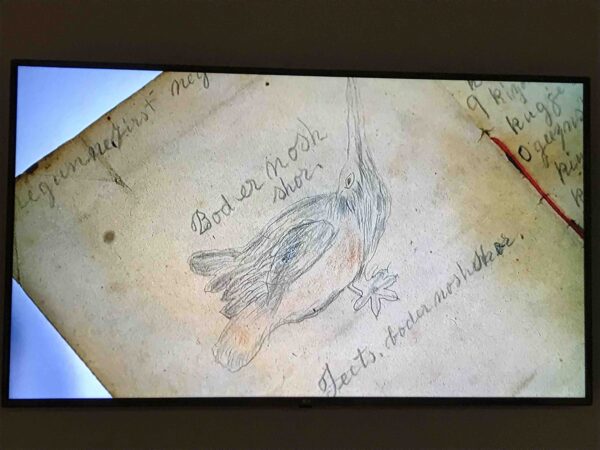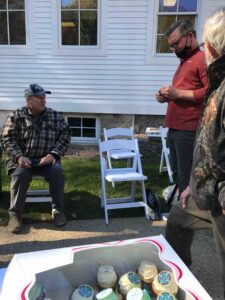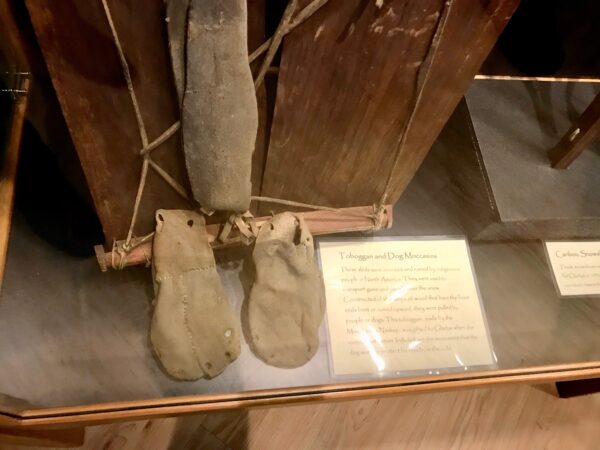Uncas Leap Walk, Narragansett Sachem Miantonomo; Then Logee’s
Take a field trip. Make it three. Not far in miles. So much to observe and absorb.
Uncas Leap.
Yantic River. #water
Afternoon walk. Awe.
For more: walknorwich.org/uncas-leap-t…
— Moo Dog Press (@moodogpress.com) November 29, 2024 at 5:12 PM
Miantonomo, Narraganset chief. A pursuit, a leap over the Yantic River falls (no dam then)? Or so the legend goes. Time since clouds the details.
From Wikipedia (because the spellings do differ on signage): Miantonomoh (1600? – August 1643), also spelled Miantonomo, Miantonomah or Miantonomi, was a chief of the Narragansett people of New England Indians.
Miantonomo supposedly hurt his leg (broken?) and may have been wearing heavy armor loaned by a friend, so Uncas caught up with him in what is now a rocky hill in Norwich, Connecticut. A stone monument is placed to remember this man. The cairn of memory stones that accumulated over years to pay respect, taken by a white man to build his house and barn foundation. (Which home and barn?) More here and words from the sign.
“The conflict with the Mohegans turned into a war in 1643. Miantonomoh invaded Mohegan territory with nearly 1,000 warriors, but was defeated. Miantonomoh was slowed by his coat of heavy armor and was taken prisoner. Miantonomoh suggested an alliance against the colonists to the sachem of the Mohegans, Uncas, but instead, Uncas brought him to Hartford to seek advice concerning further action from the Colonial Commissioners at their first meeting.
“The commissioners of the United Colonies of New England, not knowing what to do, asked a committee of five clergymen from Boston, to whom his case was referred. Although Miantonomoh had made war with their consent, albeit from Gov. John Winthrop of the Massachusetts Bay colony who knew not much of the issues concerning the two Sachems, they suggested that he should be killed while admitting they had no authority to do so. Miantonomoh was taken back to Norwich, where he had been defeated, and killed with a tomahawk by Wawequa, the brother of Uncas.” –Wikipedia
Also see: https://iconicnorwich.org/mohegan-2/— a trove of information and resources.
Walk Norwich has a well-written walk-tour with images–visits can be done in a dedicated day or over a lifetime.
And this from the Bolton Historical Society:
“Miantonomo ran for his life but was run down by the Mohegan warrior Tantaquidgeon and brought back to Uncas. Then the mighty Mohegan sachem Uncas, with a great number of his bravest warriors and wisest and most trusted advisors (sagamores), brought Miantonomo through Bolton to the colonial commissioners in the Hartford colony.
“Fearful of continual agitation among the native tribes, the New England colonies had established a regional commission to deal with relations with the tribes, as well as trade and other issues. These Commissioners of the United Colonies decided to hand Miantinomo back to be executed in Mohegan lands by his captor Uncas, thus avoiding any direct conflict between the Narragansett and English. Subsequently, Miantonomo was slain quickly by Uncas's brother Wawequa when they arrived back in Bolton Notch.
“The body of Miantinomo, with a hatchet buried in the back of his head, was never found…” (This sounds more like a fanciful imagining.)
“Observe, Concentrate and Remember.” — Harold Tantaquidgeon
Life unfolds in strange ways, but like a river finds a way.
The Tantaquidgeon Museum, 90-plus years ahead of its time, is an artifact in and of itself. Each stone placed. Stories kept.
“At the height of the Great Depression, a Mohegan named John Tantaquidgeon decided to build a dream. Although blind in one eye and on crutches, he and his children, Gladys and Harold, founded the Tantaquidgeon Indian Museum in 1931. Since that time, visitors have traveled here from around the world to experience the spirit of the Mohegans and the beauty of Native America. Featuring eastern woodland Indian artifacts, the museum’s mission is to showcase objects from a Native American perspective.”
“The Tantaquidgeon Museum's parking address is 1 Church Lane, Uncasville, Connecticut, the museum is just across the street. It is operated by the Mohegan Tribe and tours are conducted by Mohegan Tribal members.”
Note: For updates and events, when to visit, visit the museum's Facebook page, linked here.
On the drive there for the event, noting place names along the way, including Occum, Yantic (what does it mean?). Other word clues, -paug, –chaug.
From that day, a first-ever visit with my late sister, her adult daughter.
Arrival and a shuttle bus with seatbelts, meeting Al, so many stories. And here we are. Enter the Mohegan Cultural Preservation Center, a new building that serves as a gateway to visiting and orientation to the Tantaquidgeon Museum and property, related sites. A paper map and brochure is handed to each visitor. Greetings.
Gifts in baskets include arrow points, smudge bundles, a blue book with the Mohegan logo and Mundu Wigo; a pen, paper tattoo. Walking into area that showcases the actual diaries of Fidelia Fielding, one of the last fluent speakers of the Mohegan language. Getting goosebumps seeing the sketched bird and beautiful handwriting, hearing about the journey of these precious papers and glancing up at the video story displayed ahead. Wow. A language unlocked, the touchstone of a culture.

The bird drawing in Fidelia Fielding's diary, enhanced a bit for clarity in this still image from a video clip shown in the center.
“Then something unexpected happened in 1918. During the Spanish Flu epidemic, Fidelia’s adopted son, John Henry Cooper (Fielding), a carpenter working in Norwich, CT, came home to quarantine on the reservation in his mother’s old cabin. With little to do, he rummaged through her old things and papers. Among them, he found several of Fidelia’s forgotten diaries. He contacted Speck—-now chair of the Department of Anthropology at the University of Pennsylvania—-to share the incredible news. When the flu pandemic subsided, Speck asked Gladys Tantaquidgeon, by this time a young adult, to join him in researching the diaries and other papers that recorded Mohegan historical records, traditional stories, beliefs, and cultural practices. Tantaquidgeon worked with Speck to adapt some of this information into a publication for the Bureau of American Ethnology, and was also inspired to write her own book, Folk Medicine of the Delaware and Related Algonkian Indians (Pennsylvania Historical and Museum Commission, 1941, reissued in 1972).
“When Gladys, her brother Harold, and their father John founded the Tantaquidgeon Indian Museum in 1931, they hoped to archive Fidelia’s papers alongside other Mohegan records and heritage items. Speck held onto the diaries for two more decades, but after he passed away unexpectedly in 1950, the other Mohegan items were nowhere to be found.”
–excerpt from Library Journal Mohegan Tribe, Cornell Partner to Repatriate Fidelia Fielding Diaries by Lynn Malerba, Melissa Tantaquidgeon Zobel, & Tamar Evangelestia-Dougherty; March 04, 2021
(Will repeat: Why, oh why, is this not taught in schools with field trips, meet the people who carry the history forward?)
“Prior to European settlement, the Mohawk and other Native American tribes utilized the trail to fish during the annual spring salmon runs up the Connecticut and Deerfield Rivers and to hunt the lush valleys surrounding the rivers. They also used the trail to make raids on their enemies. Toward the end of King Philip’s War in 1676, Metacom, also known as King Philip, the leader of the Wampanoag Confederacy, traveled the trail and failed to recruit the Mohawks in his war against the settlers. The trail also became a principal route of the French and their Native American allies during the French and Indian War from 1754 to 1763. During the American Revolution, Benedict Arnold, still an American patriot at the time, traveled the trail recruiting additional troops while on the way to Fort Ticonderoga, New York, with his letter of command.”
—U.S. National Park Service history
For more about the Mohegan Language Restoration Project, see https://www.mohegan.nsn.us/about/information/restoration-project#:~:text=The%20Mohegan%20Language%20Project%20pieces,tribes%20who%20have%20similar%20dialects.Nearby, legendary Logee's Tropical Plants, greenhouses in Danielson, Connecticut.
Did you know? Logee’s Greenhouses was started by William D. Logee in 1892 in Danielson, Connecticut. It began as a cut…
Posted by Logee's Tropical Plants on Wednesday, September 20, 2023
Editor's note: This story was published in part originally in 2021. To be present on Nov. 6, 2021, such an honor. From wampum, Uncas, maps to chart other excursions. The healthy trees. Gingko circle behind the church. Ordering books related to these places, people stories. The Mashantucket Pequot Tribe across the river, local libraries. Rivers and reading the signs along the way. Just the beginning; this story has been updated.


